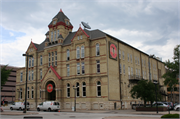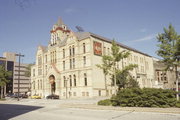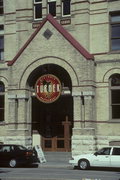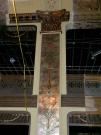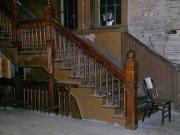Property Record
1034 N Vel R. Phillips Ave (AKA 1034 N 4TH ST)
Architecture and History Inventory
| Historic Name: | Turner Hall |
|---|---|
| Other Name: | Turnverein Milwaukee Hall |
| Contributing: | |
| Reference Number: | 32151 |
| Location (Address): | 1034 N Vel R. Phillips Ave (AKA 1034 N 4TH ST) |
|---|---|
| County: | Milwaukee |
| City: | Milwaukee |
| Township/Village: | |
| Unincorporated Community: | |
| Town: | |
| Range: | |
| Direction: | |
| Section: | |
| Quarter Section: | |
| Quarter/Quarter Section: |
| Year Built: | 1882 |
|---|---|
| Additions: | |
| Survey Date: | 200020102019 |
| Historic Use: | meeting hall |
| Architectural Style: | Romanesque Revival |
| Structural System: | |
| Wall Material: | Cream Brick |
| Architect: | HENRY C. KOCH |
| Other Buildings On Site: | |
| Demolished?: | No |
| Demolished Date: |
| National/State Register Listing Name: | Turner Hall |
|---|---|
| National Register Listing Date: | 11/7/1977 |
| State Register Listing Date: | 1/1/1989 |
| National Register Multiple Property Name: |
| Additional Information: | A 'site file' exists for this property. It contains additional information such as correspondence, newspaper clippings, or historical information. It is a public record and may be viewed in person at the Wisconsin Historical Society, Division of Historic Preservation. The WHS holds a covenant on this property in perpetuity. BECAME A NHL ON 11/15/1996. Turner Hall is as German as Milwaukee gets, yet its exterior offers little clue as to the building's ethnic roots. The Turnverein date from 1811 when Frederick Ludwig Jahn founded the first Turnverein in Germany, teaching gymnastics and calisthenics for physical fitness and mental self-improvement. Turners linked such self-improvement to wider political and social reforms. Turner reform impulses underlay Germany's unsuccessful liberal revolutions in 1848. When German immigrants fled to America in the 1840s and 1850s, they established the Milwaukee Turnverein in 1853. While most American Turnvereins became social and cultural clubs after the Civil War, the Milwaukee Turnverein never relaxed its quest for political reform. Beginning in the 1890s, the organization forged close ties to the local and national Socialist parties. Many Milwaukee Turners were involved in radical journalism, labor organizing, or won election to local or national offices. In 1910, two prominent Turners took office: Victor Berger, America's first Socialist congressman, and Emil Seidel, the first of Milwaukee’s Socialist mayors. Interior remodeling in 1995 brought Turner Hall back to life. Above the spacious oak-paneled first-floor dining areas are murals depicting patriotic American historic events. Historic photographs display the Turners’s gymnastic regimen and social festivities. At the rear of the building, a two-story members-only gymnasium, still used by Turners, retains its original features. A 1930s fire closed the maple-floored two-story ballroom that occupies most of the second and third floors. A deliberate restoration effort reveals decorative gilt on blue wall stenciling, cherubim that inhabit murals on the curved ceiling, a raked stage that enabled audiences to enjoy each performer’s intricate footwork, and a massive gas chandelier with mirrored reflectors, among the largest of these rare fixtures extant in Wisconsin. Of Milwaukee’s several original Turner buildings, this alone survives. Julius Hauboldt was the masonry contractor. Last map code was 151/20 on a LUQS 392 map. Surveyed for Milwaukee Downtown Connector Arch/History Survey, SHPO#10-0983, Prepared by Heritage Research (2010). Update photo provided. This Romanesque Revival clubhouse, "Turner Hall," was erected in 1882-1883 and designed by Henry Koch. The Turner Society was established in Milwaukee in 1853. Several halls were once located throughout the city; however, the subject hall now stands as the sole testament to the Turner organization, which continues to operate today. Turner Hall was listed on the National Register of Historic Places in 1977, designated as a city landmark in 1986 and, as a National Historic Landmark, in 1996. Because of the structure's national significance, it was determined that it should be noted that Turner Hall stands within approximately 1 1/2 blocks from the project area. Covenant/Easement: In Perpetuity. Effective 3-29-2007. A 'covenant file' exists for this property. It may contain additional information such as photos, drawings and correspondence. It is a public record and may be viewed in person at the Wisconsin Historical Society, State Historic Preservation Office. 2019 - Resurveyed (streetcar project). NR-listed, NHL-designated. Update photo. |
|---|---|
| Bibliographic References: | BUILT IN MILWAUKEE, LANDSCAPE RESEARCH, P. 9. MILWAUKEE HISTORIC BUILDINGS TOUR: KILBOURNTOWN, CITY OF MILWAUKEE DEPARTMENT OF CITY DEVELOPMENT, 1994. MILWAUKEE JOURNAL SENTINEL 5/17/1995. MILWAUKEE JOURNAL SENTINEL 9/18/1996. Black River Falls Banner Journal 3/19/1997. Milwaukee Landmark Form. Buildings of Wisconsin manuscript. Pagel, Mary Ellen & Virginia A Palmer, University Extension The University of Wisconsin, Guides to Historic Milwaukee: Kilbourntown Walking Tour, 1967. |
| Wisconsin Architecture and History Inventory, State Historic Preservation Office, Wisconsin Historical Society, Madison, Wisconsin |

